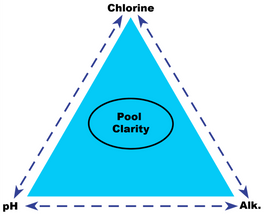Published by EZ Pool & Spa Supply on 03/23/2020
Chlorine, pH, and Alkalinity: Why Do They Need to be Balanced?
The Triangle of Pool Clarity
The proper ranges for swimming pool water are the following:
Chlorine = 1.0 – 4.0
pH = 7.2 – 7.6
Alkalinity for Vinyl = 100 – 150
Alkalinity for Gunite = 80-120
Note: Gunite pools have calcium hardness levels of 200 – 400. Hence, we want alkalinity lower to reduce the chance of cloudiness.
--
Chlorine, pH, and alkalinity essentially all work together. The proper balance or lack of balance of one will impact the balance or performance of the others. In a perfect world, we optimize the swimming pool water and it all stays in range. However, our pools are part of our environment. The wind, rain, bather load, sweat, oil, all of these items cause the pool water to be in a constant state of flux.
First let’s talk about alkalinity, it is a base buffer to pH, providing pH support. If alkalinity is low the pH of the pool water will bounce up and down the pH of the water will not be consistent. Increase this with Alkalinity Rise. Take Away: When alkalinity is in range, pH tends to stay in range
What do chlorine and pH mean to each other? The ideal chlorine range is 1.0 – 4.0 and pH is 7.2 – 7.6
Results of low pH include the swimming pool water becoming acidic. Other consequences include bothersome eye burn, and corrosion of pool equipment. Increase this with pH rise.
Lastly, chlorine is hyperactive and you end up using more than is needed. With high pH, the water tends to scale causing calcium deposits on the equipment and walls. Chlorine is not as effective. It takes a high level of chlorine to have the same sanitization effect. Reduce this with pH Down.
Take Away: There is an inverse relationship between chlorine and pH. As pH rises, chlorine’s effectiveness decreases. As pH decreases chlorine’s effectiveness increases but in a wasteful way. You are using more chlorine than necessary. Remember to test your water weekly and keep the chlorine, pH, and alkalinity in ranges.
We recommend to have your water tested professionally 3 times per year at the beginning, the middle, and the end of pool season, while also using test strips in between.
Optimization of swimming pool water can be achieved using balancing chemicals, chlorine, and test strips. All of these are available at the links provided below:
| Chlorine |
Test Strips |
Alk. Rise |
pH Rise |
pH Down |







